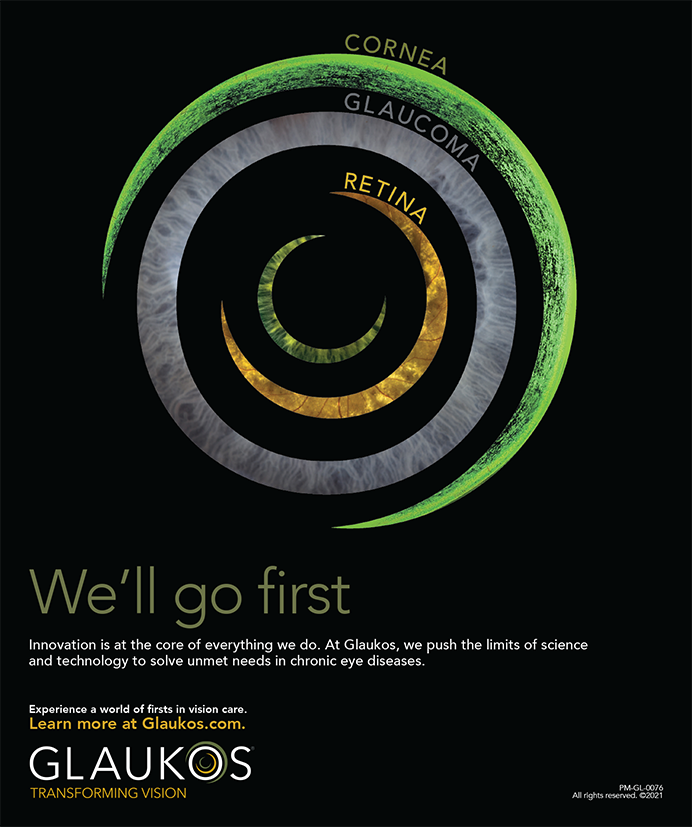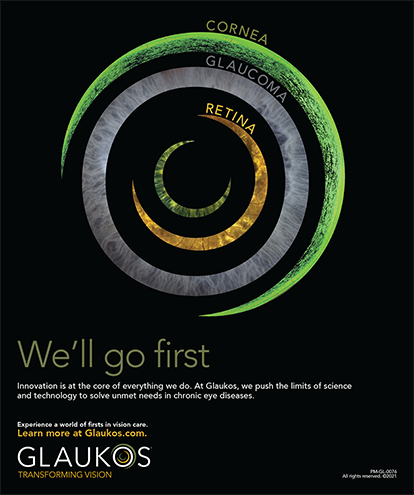CASE PRESENTATION
A 55-year-old man was referred to me by a surgeon who, at the start of routine cataract surgery, had been surprised to discover 180º of missing zonules in the patient’s right eye with a fully dilated pupil. The surgeon closed the eye before opening the capsule.
On presentation, BCVA was 20/50 OU with a highly myopic prescription, yet biometry showed an average corneal shape and axial length in each eye, indicating that the implantation of an 18.00 D IOL would yield emmetropia. This apparent disconnect turned my thoughts to spherophakia. In eyes with this rare congenital disorder, the lens rounds up, giving it a greater anteroposterior diameter and therefore greater refractive power.
The pupil of the right eye dilated poorly after the instillation of standard tropicamide eye drops (Mydriacyl, Alcon). IOP was in a normal range in each eye. Except for 2+ nuclear sclerosis, the slit-lamp examination was normal, with no evidence of phacodonesis or angle compromise. More aggressive pharmacologic dilation of the pupil confirmed nearly 180º of missing zonules inferiorly. The retinal examination was within normal limits and found no stigmata of myopia. An examination of the fellow eye was nearly symmetric with regard to zonular absence and the cataract.
After a thorough discussion of the risks and benefits of cataract surgery and refractive goals, the patient decided to proceed with surgery.
How would you manage this case? Are there specific tools you would have on hand?
—Case prepared by Lisa Brothers Arbisser, MD

NATALIA ANISIMOVA, MD, PHD
After reopening the corneal paracentesis, I would inject triamcinolone acetonide solution into the anterior chamber in order to check for the presence of vitreous strands. I would instill a dispersive OVD to maintain the anterior chamber and push the vitreous, if present, posteriorly. Because the zonular support of the capsule is insufficient, a laser capsulotomy would be a valuable option. If a femtosecond laser is not available, I would consider puncturing the anterior capsule with a cystotome or capsulorhexis forceps with sharp tips. It would be important to initiate the capsular tear in a superior direction. Capsular hooks could be used if needed to stabilize the capsular bag.
After completing the continuous curvilinear capsulorhexis (CCC), I would place at least three capsular hooks in the anterior chamber to prevent aqueous misdirection syndrome. Clipping the iris to the anterior capsule with capsular hooks would significantly reduce the risk of disrupting the anterior vitreous face during phacoemulsification.1
After cataract removal, a surgical device could be employed to improve capsular stability. Possibilities for this include a Malyugin/Cionni Capsular Tension Ring (CTR, FCI Ophthalmics), a capsular tension segment with a fixation eyelet, or an AssiAnchor (Hanita Lenses, not available in the United States) with transscleral suture fixation. The type of suture material for scleral fixation requires some thought. I would avoid a 10-0 or 9-0 polypropylene suture (Prolene, Ethicon) because of the risk of late postoperative breakage from rubbing.2 Instead, I would use a 6-0 polypropylene suture because the larger caliber might reduce the risk of breakage.
The tip of a 6-0 polypropylene suture would be threaded through the eyelet of a Malyugin/Cionni CTR and cauterized until an adequately sized flange was achieved. After the capsular bag was filled with a cohesive OVD, a CTR would be injected into the capsular bag and then bimanually rotated so that the eyelet was located at the 12 clock position. The other end of the suture would be externalized transsclerally with a 27-gauge guide needle, cauterized to form a second flange, and buried in the scleral tunnel. The capsular hooks and OVD would be removed. Alternatively, a polytetrafluoroethylene suture (PTFE, Gore-Tex, W.L. Gore & Associates, off-label use) could be used to fixate the CTR.

AUDREY R. TALLEY ROSTOV, MD
Care must be taken to proceed as gently as possible to avoid dropping the nucleus and to achieve a good visual result with a posterior chamber IOL.
I would perform a peribulbar block and ensure wide dilation of the pupil by administering phenylepherine 10%, tropicamide, and a topical NSAID preoperatively.
Laser cataract surgery would be my preference in this case in order to minimize stress on the zonules. I also find that laser cataract surgery allows me to complete the capsulotomy safely in eyes with zonular compromise. Moreover, I can center the capsulotomy exactly on the bag and move the capsulotomy to reflect this before the laser treatment is initiated. In my experience, laser prefragmentation of the nucleus facilitates access to the fragments and thus aids in their removal.
I would create two incisions to facilitate bimanual surgery and inject a dispersive OVD. After removing the capsulotomy with microforceps, I would gently viscodissect the nuclear fragments into the anterior chamber and place capsular hooks to support the capsule in the area of missing zonules. I would perform bimanual phacoemulsification, irrigation, and aspiration. If the entire bag started to dehisce, I would elevate the remaining nuclear and cortical material into the anterior chamber and remove it with phacoemulsification, irrigation, and aspiration.
If the remaining zonules were intact and appeared to be stable, I would suture a capsular tension segment in the area of zonular loss and place a CTR in the bag for stability. If, however, the zonules were not stable, I would sacrifice the bag, execute a bimanual anterior vitrectomy, and perform intrascleral fixation of an IOL using the Yamane technique and an anterior chamber maintainer. For either scenario, I would choose a three-piece IOL such as the CT Lucia 602 (Carl Zeiss Meditec) or Sofport (model LI61AO, Bausch + Lomb).

WHAT I DID: LISA BROTHERS ARBISSER, MD
My plan was to use the capsular bag to secure a one-piece hydrophobic acrylic IOL. The bag was to be fixated to the sclera by a Cionni CTR (FCI Ophthalmics) with PTFE sutures. An Ahmed Segment (FCI Ophthalmics) was on hand in case two-point fixation became necessary, and a three-piece IOL was available for iris or scleral fixation in case the bag was lost.
After administration of a peribulbar block, a dispersive OVD was instilled nasally through a paracentesis to cover the area of zonular loss, and a cohesive OVD was then injected to compartmentalize the vitreous body. I chose to move the incision superiorly to the 12 clock position so that it was 180º away from the area of greatest zonular loss and in order to avoid the temporal incision created during the previous aborted cataract procedure. I sat at the head rather than my usual position temporally. Making this OVD fill quite firm allows the surgeon to perform a one-handed CCC, potentially the most difficult part of the cataract procedure in an eye with zonulopathy. The use of a femtosecond laser could have been beneficial, but this technology was not available at the time of this case. My low-tech approach created a slightly small CCC, which I enlarged with Vannas scissors and a spiraling technique after the bag had been secured with a CTR. I placed Yaguchi-Kazowa double hooks (Handaya) to support the bag because they require very small incisions, distribute the forces along the CCC edge, and do not obstruct CTR insertion. Care must be taken, however, to prevent the posterior capsule from flopping forward because these retractors do not support the equator to the same extent as MST Capsule Retractors (MicroSurgical Technology). The latter instruments would have been a viable alternative.
During phacoemulsification, I decreased my usual rise time and flow parameters for greater control; speed was not the goal. Supporting the loose capsule with suspension hooks allowed me to perform nearly routine vertical phaco chop. Cortex was removed first from the area with the strongest zonules. A Cionni CTR was then threaded with CV-8 PTFE sutures and introduced into the capsular fornix. I was careful to keep the eyelet above the CCC rim. Once the CTR was in position, the capsule hooks were removed. The curved needles of the double-armed suture were straightened with two needle holders to facilitate docking into a 26-gauge needle, which was placed 2 mm behind the limbus in the meridian central to the area of missing zonules in an ab externo fashion under a fornix-based flap. Just before needle puncture, a jot of dispersive OVD was placed in the sulcus, where the entry was intended, to push down the anterior capsule while elevating the iris; this created ample space for needle entry just above the anterior capsule. One end of the suture was docked into the 26-gauge needle orifice (with care taken not to incorporate any corneal fibers on entry through the clear corneal incision) and withdrawn through the sclera. The second arm was engaged and docked through a second puncture located a few millimeters away at the same distance from the limbus and similarly brought out through sclera.
I was careful not to tie the suture tightly so that the bag was centered and suspended by the PTFE sutures, allowing it to act as a synthetic zonule. I prefer a 1-1-1-1 knot, which I tie over one of the 26-gauge puncture sites so that the suture does not require rotation. A Sinskey hook was used to bury the knot into the tunnel intrasclerally. Tenon capsule and the conjunctiva were sutured over the entry site with an 8-0 polyglactin suture (Vicryl, Ethicon), and the knot was buried for the patient’s comfort. The CCC was enlarged for symmetric coverage of the IOL optic, and the lens was positioned in the capsular bag. The OVDs were carefully removed with irrigation and aspiration. Dilute triamcinolone acetonide (Triesence, Alcon) was instilled in the anterior chamber to confirm that no vitreous had presented and to decrease inflammation. An intracameral injection of moxifloxacin was performed.
When using akinesia-inducing anesthesia, my preference is to splint the upper eyelid shut with 1-inch plastic tape oriented horizontal to the lash line and affixed between the upper lid margin and the orbital rim. A tab of tape is left that allows the patient to lift the eyelid and instill postoperative drops. In my experience, using this splinting technique in lieu of a patch prevents exposure, and it eliminates the risk of corneal abrasion and the need for ointment associated with pressure patching. Patients can easily remove the splinting tape when the eyelid begins to function normally as the anesthetic wears off.
One day after surgery, BCVA was 20/20 with a trivial prescription. The patient underwent cataract surgery on the contralateral eye 1 month later. Visual acuity has been stable in both eyes for nearly 10 years.
1. Sethi HS, Mayuresh NP, Gupta VS. Intraoperative intracameral pilocarpine after capsular tension ring and capsule/iris hook insertion in pediatric eyes with subluxated cataract. J Cataract Refract Surg. 2016;42(2):190-193.
2. Anisimova NS, Arbisser LB, Shilova NF, Kirtaev RV, Dibina DA, Malyugin BE. Late dislocation of the capsular bag–intraocular lens–modified capsular tension ring complex after knotless transscleral suturing using 9-0 polypropylene. Digit J Ophthalmol. 2020;26(2). http://www.djo.harvard.edu/site.php?url=/physicians/cr/4117




